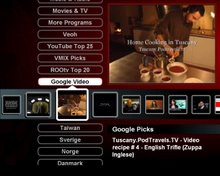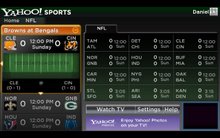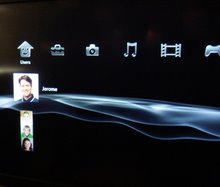The Issue: Google and others want a role to play in support of the living room TV. But how are TVs developing such that Google can have a role.
Behind the scene: Most if not all TV manufacturers are developing models with network support. These UPnP TVs enable media to be transferred between the TV and other networked PCs, appliances and servers.
Solution: The likely next-step after adding UPnP networking is for TVs to support browsing of TV-formatted websites. The life expectancy of a TV is long. This is why a TV may have Ethernet built-in but wireless networking technology, which changes more frequently, is likely left to an external add-on. Will browser technology be built-in or will it be left to as an external support role.
Efforts to get the PC and TV to work together continue. There is a desire to have PCs, TVs and hand-held devices, cooperate with each other. But as reported by the Wharton Business School, it is proving difficult to develop solutions which gain broad market acceptance.
One solution which has emerged with broad acceptance is the inclusion of Universal Pug and Play, UPnP, in new networked TVs. Further evidence of this is Google’s recent announcement of a PC UPnP server – Google Media Server. As mentioned in the NYT, a key point in their announcement is: “Google can offer a hardware maker a very easy way to add Internet video capability to a television”.
The last100 blog reports the Google server “works in conjunction with Google’s desktop search application - Google Desktop - to locate various media (photos, music and video) stored on your PC and make it available for streaming over a home network to any UPnP compatible or DLNA ‘certified’ device, such as a PlayStation 3” or TV.
There are already plenty of PC UPnP servers available, so why is Google entering the game? The Google PC sever can process information about media - know as metadata - in interesting ways. This can remove the TV from the burden of organizing media. A PC user can search and arrange media which is later enjoyed at the TV.
The information provided by the Google UPnP server need not relate to only PC-stored media, but also include information about web-accessible media. Perhaps the PC server is only a piece of the Google plan. A TV accessing web-video could be assisted by the PC’s UPnP sever, and make use of the media information organized at the PC.
A TV connecting with a Google server via broadband to the home can use the existing YouTube video library API to access video directly via the TV’s internet connection. Of course a broadband connected TV could also access some other video severs’ video resource. If Google extended its API it could upload meta-data from the PC sever to a Google web-sever. A broadband connected TV could then make access to the media meta-data without requiring networked PC assistance.
In all cases, the UPnP TV User Interface (UI) is determined by local TV firmware and not sent over the network connection. The media may be sent to the TV over the network, but it is up to each TV manufacturer to decide how to present the media on the TV screen. A UPnP TV is a step forward but it is not equipping a TV with the browser capability of a PC; where PC-webpages are sent over the network and used to format the PC display. So what is the next step for the UPnP TV?
It is clear that TV owners want some things built-into their TV and some things left out. They don’t want a VCR built-in, they don’t want a DVD player built-in, they do want a digital broadcast tuner built-in. With next generation TVs, customers want home network support, including UPnP access to media held on a PC.
TV purchasers want to also view video and photos delivered over the web; But it is not clear if the web browser and its plug-ins should be built into the TV or supported by an external box of some kind. Maybe TVs will be built both ways. One clear option is to use an existing networked PC as the “external box” supplying the TV with browser support.
Internet video broadcasters and TV-website developers, should be required to build a single TV-oriented TV-website which works with, both, a TV using a built-in browser, or a TV using an external browser. In the same way a VCR tape works with a built-in player or external tape player.
Flash is the most widely used browser plug-in. It seems essential that a browser built into the TV must support Flash. However, embedded browser developers are still finding it hard to integrated Flash into a TV-sized browser. (Apple TV has the internals and cost structure of a PC, not a low-cost TV chip.) Until this task is accomplished, it is much easier to use active-TV technology to support the TV with an external browser which does have Flash support. In fact for some TV purchasers may continue to prefer this approach. We don’t yet know.
The recent Adobe announcement regarding removing licensing fees when embedding Flash into non-PC video play-back devices, will help ensure Flash as the next “standard” beyond UPnP. TVs and STBs using Flash and AJAX (web 2.0 technology) can accomplish much more than a TV only utilizing UPnP.
Feedback, corrections and comments welcome. Please Contact me for more information or support with active-TV technology development.
Daniel Mann
Navigate YouTube available at iTunes App Sore
An easy to use iPhone and iPod touch App that enables both new and advanced YouTube users to get the best from YouTube.
Browse video Standard Feeds, Categories, Channels and Playlists. Then organize new videos into your own favorites and playlists. Make playlists private or public. Subscribe to other user's playlists and video collections for future viewing. Subscribe to videos matching search-words.
Look at publicly viewable favorite videos, playlists and subscriptions based on your YouTube friends, family and contacts. Send and receive video links with YouTube contacts via YouTube video messages.
Search for new videos tagged for your language or geographical region, using local keyboard. Explore for new videos via easy switching of user ID to the owner of interesting videos - then explore their world.
All actions are kept in sync with PC, Mac or Apple-TV access to YouTube. Available at Apple App Store.
Browse video Standard Feeds, Categories, Channels and Playlists. Then organize new videos into your own favorites and playlists. Make playlists private or public. Subscribe to other user's playlists and video collections for future viewing. Subscribe to videos matching search-words.
Search for new videos tagged for your language or geographical region, using local keyboard. Explore for new videos via easy switching of user ID to the owner of interesting videos - then explore their world.
All actions are kept in sync with PC, Mac or Apple-TV access to YouTube. Available at Apple App Store.
active-TV technology for PC

Windows PC based home network
Subscribe to:
Post Comments (Atom)










1 comment:
Thanks, good information !!
Who ever controls technology,
controls world.
Roman emperors ruled the world because they built roads.
Britisher’s ------ built ships
Russians ------ built spaceships
Americans invented Atom bombs and Americans stills rules the world with Information technology.
Study the latest tech news and tips at http://mothertech.blogspot.com/
Post a Comment